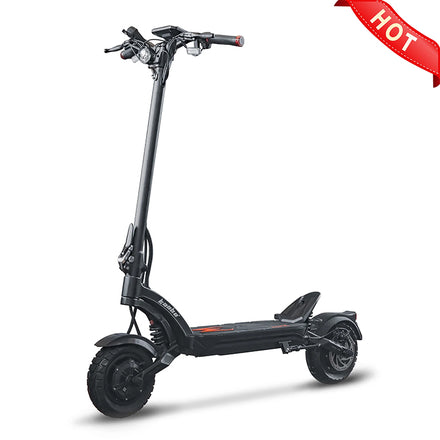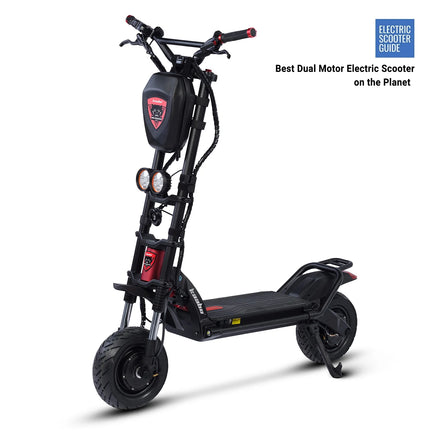Which Is More Economical for Long-Range Electric Scooters, Subscription or Rental?
Due to their comfort and environmental friendliness, electric scooters have become incredibly popular in recent years. The alternatives for purchasing electric scooters have expanded along with the demand for them. In this blog, we'll look at the affordability of two well-liked ways to get long-range electric scooters: subscription and rental.
The Rise of Electric Scooter Subscriptions
People now frequently use subscriptions to obtain electric scooters without making the commitment of complete ownership. Users that choose the subscription model pay a monthly fee in exchange for unlimited usage of a scooter.
Cost Comparison: Subscription vs. Rental
It is critical to take both the initial investment and recurring costs into account when determining whether long-range electric scooters are cost-effective. Let's examine the costs involved in subscribing an electric scooter as opposed to renting one.
Initial Investment
The lesser initial cost is one of the major benefits of a subscription plan. Subscribers often pay a monthly charge that covers all maintenance and insurance expenses rather than purchasing the electric scooter up front. As customers may stretch their payments out over time, this is frequently a more economical choice.
Contrarily, customers using a rental model must pay a one-time rental cost for each use. Although initially this may appear to be more expensive, it's crucial to take the frequency and length of scooter riding into account. Since you won't be required to pay a monthly charge while the scooter isn't in use, renting may end up being more cost-effective in the long run if you only need a scooter sometimes.
Ongoing Costs
Subscription models often include maintenance and repairs in the monthly charge in terms of recurring expenses. As a result, customers have peace of mind knowing that they won't face any unforeseen costs. Additionally, if any maintenance or repairs are required, the business may handle them.
However, while renting something, the consumer is in charge of paying for any maintenance or repairs that could be required throughout the rental time. Although these expenses can add up, they are frequently countered by the fact that scooter renters are not required to pay a monthly charge when the scooter is not in use.
Insurance and Liability
When it comes to insurance and liability, there are a few key differences between subscription and rental e-scooters:
- Ownership: With a subscription e-scooters, you typically have long-term access to the scooter and may even have ownership rights. This means that you will likely be responsible for obtaining your own insurance coverage for the e-scooter, similar to how you would for a personally owned vehicle. On the other hand, rental e-scootersare usually covered under the rental agency's insurance policy, and you may have the option to purchase additional coverage or waivers to reduce your liability.
- Cost: Since you are responsible for obtaining your own insurance coverage with a subscription e-scooters, the cost of insurance will depend on various factors, such as your driving record, location, and the type of coverage you choose. Rental e-scooters, on the other hand, usually include insurance coverage as part of the rental package, so you do not have to worry about additional insurance costs.
- Liability: With a subscription e-scooter, you are typically responsible for any damages or liabilities that occur while the vehicle is in your possession, similar to owning a personally owned vehicle. This means that if you cause an accident or damage the e-scooter, you may be liablefor the repairs or any bodily injury or property damage that results from the incident. With rental e-scooters, the liability may vary depending on the rental agency's policy. In some cases, the rental agency may hold the primary liability for any damages or liabilities, while in others, you may be responsible for a certain deductible or liability limit.
It's important to carefully read and understand the terms and conditions of both subscription and rental agreements to fully grasp the insurance coverage and liability implications. Additionally, it may be beneficial to consult with an insurance provider or rental agency representative to ensure you have the appropriate coverage or understand your liability in case of an accident.
Long-Term Usage
The amount of time spent using a scooter is another thing to think about. A subscription approach can be more economical if you plan to use a scooter frequently for a long time. Subscribers who pay a monthly subscription can access a scooter anytime they need it without worrying about extra rental fees.
On the other hand, renting a scooter might be a more cost-effective option if you just want to use one occasionally or for a short time. Renting a scooter allows you to just pay for the time you actually use it, thereby saving you money.
Non-cost Comparison: Subscription vs. Rental
Ownership
With a subscription service, users have access to a personal electric scooter, which they can use whenever they need it. This ownership-like experience provides convenience and familiarity, as users can customize their scooter settings to their liking. In contrast, rentals provide a no-strings-attached experience, where users can rent a scooter on-demand without the responsibilities of ownership, such as maintenance and storage. Rentals are best suited for occasional users who don't require a personal scooter.
Availability and Accessibility
Rental services often have a larger fleet of scooters available, making them more accessible to users. Riders can easily find and rent a scooter through a mobile app, usually within a few minutes. In contrast, subscription services may have a limited number of scooters available, and users may need to reserve their scooter in advance. Availability and accessibility can vary depending on the location and popularity of the service, so users should consider this factor when choosing between subscriptions and rentals.
Flexibility
Flexibility is another important trade off to consider. Rentals offer users the freedom to use a scooter whenever and wherever they need it, without being tied to a specific subscription period. This flexibility is particularly beneficial for one-time or sporadic scooter use. Subscriptions, on the other hand, require a commitment to a specific duration, usually monthly or annually. While this commitment may provide stability for regular users, it can be limiting for those who have varying usage patterns.
Examples of cost-effective scooter subscription and rental programs
- Bird:
Bird offers a monthly subscription plan called Birdie Pass . Subscribers get unlimited rides on any Bird scooter for up to 30 minutes each ride, without any unlocking or per-minute fees. This plan can be cost-effective for individuals who use scooters frequently for short-distance trips.
- Spin:
Spin offers a Spin Access Pass in which subscribers get unlimited 30-minute rides on any Spin scooter. Additionally, they provide a discounted unlock fee of $1 instead of the usual $2. This plan is beneficial for individuals who use scooters frequently and for longer rides.
- Jump:
Jump, a division of Uber, offers a Jump Pass whereby Subscribers get 30 minutes of free ride time per day on any Jump scooter or bike. This plan is useful for regular riders who want to save on daily commutes or short trips.
- Scoot:
Scoot offers a Scoot Club membership. Members get access to discounted rates on scooter rentals, at lower prices for a 30-minute ride. This plan is suitable for riders who frequently use scooters and want consistent savings on rental costs.
These examples demonstrate various cost-effective scooter subscription and rental plans available in the USA. The pricing and features may vary, so it's essential to review the specific terms and conditions of each plan before subscribing.
Conclusion
In conclusion, a number of variables, like your usage habits, location, frequency of use, and desired level of ownership, might affect how cost-effective long-range electric scooters are. The decision between a subscription and a rental ultimately depends on personal objectives and circumstances. Renting is more suitable for occasional users who prioritize flexibility and cost-efficiency in the short term. Subscriptions, on the other hand, are more beneficial for frequent users who want the convenience and ownership experience of having a personal scooter. Before choosing which alternative is the most cost-effective for long-range electric scooters, it is crucial to thoroughly consider your usage requirements and financial condition.Users should consider their own needs and preferences to make an informed decision that best meets their requirements.
Lastest Blog Post






Related Product
Newletter
Promotions, new products and sales. Directly to your inbox.





















